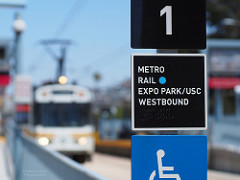Metro Proposes Budget Changes To Regional Connector
L.A. commuters will have to wait longer to use Metro’s regional connector train, which will link three major rail lines. Metro today announced a proposed budget increase and new projected opening date for the construction project.
Metro has asked its board to revise the project budget to add an additional $132 million.
The original budget was $1.42 billion. In addition, Metro expects to move the opening date from late 2020 to May 2021.
Metro spokesperson Rick Jager said problems with electricity relocation contributed to the delays.
“In the course of building the regional connector, which is an underground light-rail project, we have experienced some unexpected things,” said Jager. “We did not expect problems with utility relocation work, which has driven up the cost significantly.”

Prior to starting the project, Metro had been given a $92.7 million reserve in case of unexpected cost increases. The reserve was supposed to last five years, but over half of that money has been depleted.
In addition, the project has had issues with the permit process and right-of-way acquisition, which has impacted time and budget, said Jager. Metro expects the additional funds will be able to complete the project.
“The process is costing significantly more than what was projected in the proposed budget,” said Jager. “The additional money in the reserves should be able to handle any unexpected encounters and move the project forward.”
Once completed, the regional connector will connect the blue, gold and expo lines. Commuters will have a one-seat, one-car ride, without having to pay multiple fares.
The goal of the connector is to allow riders to travel multiple lines without having to get off the train to switch to another, said Jager.
The connector will add three new train stations to downtown L.A. They will be at 1st Street and Central Avenue, 2nd Street and Broadway, and 2nd and Hope Streets.
“It will allow riders to travel from Azusa to Long Beach, Los Angeles or Santa Monica without the need to transfer between rail lines on the major east, west, north and south trips,” said Jager.
Metro expects the connector to carry about 88,000 passengers by the end of 2020.
More than 17,000 new daily riders are expected to take the Metro lines when the regional connector is finished.
Metro wants riders to remain patient as the budget is worked out, said Jager.
“It’s a densely populated area in downtown Los Angeles so there’s a lot of unknowns that you’re tunneling,” said Jager. “We’re trying to do our best here in terms of bringing this project on time on budget.”
Listen to the radio piece here.










